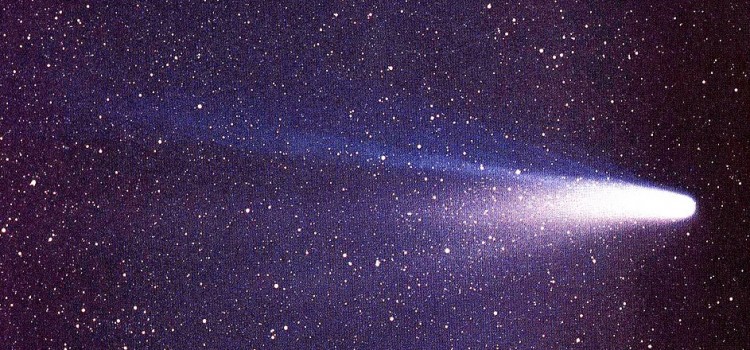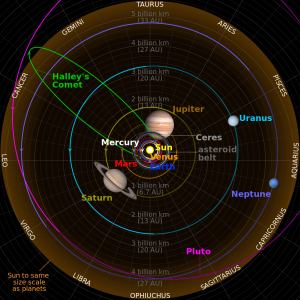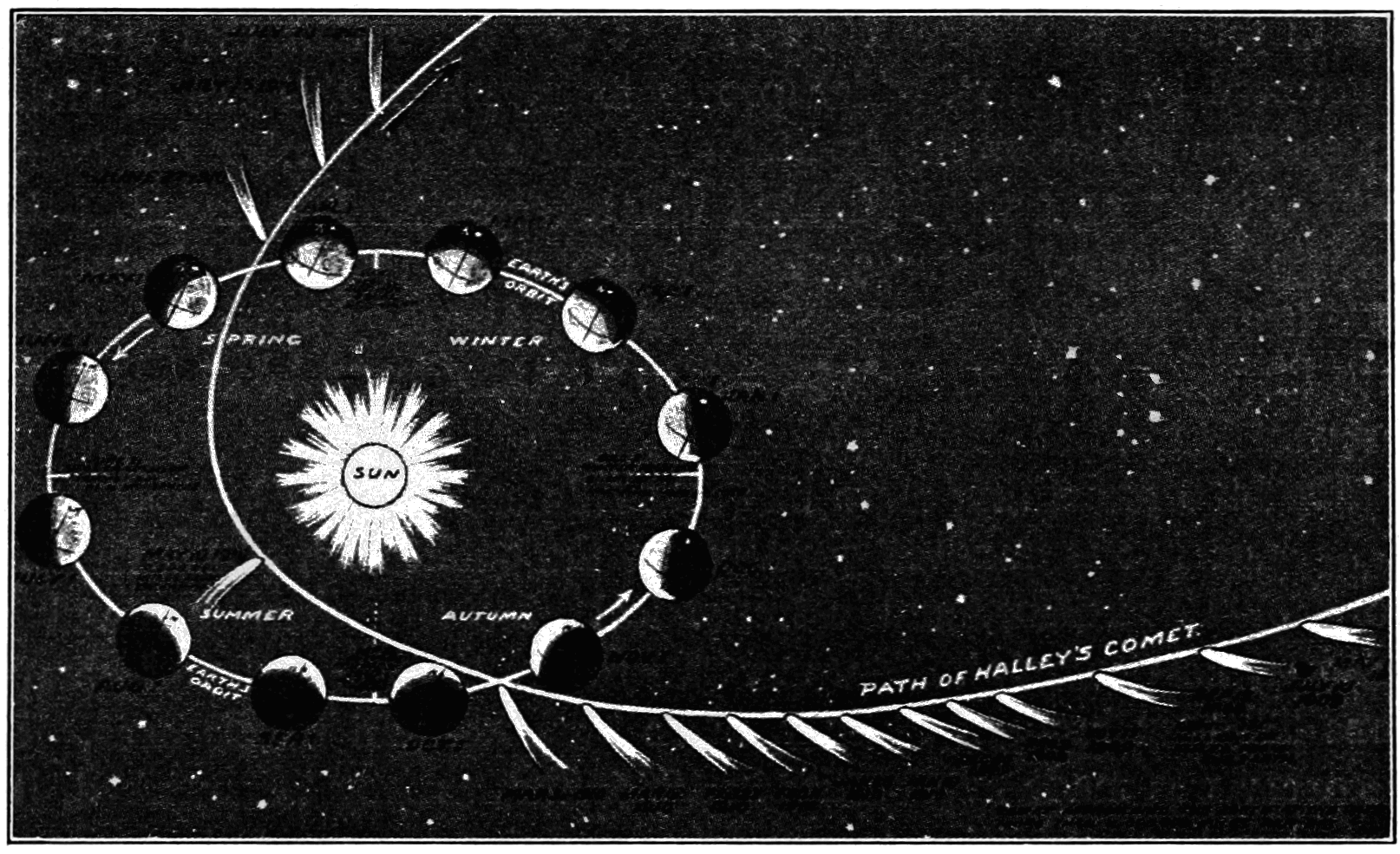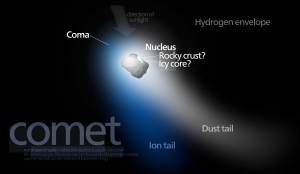Comets: A Dance of Ice and Dust
Rachel Cooper, Jesse McLellan, Jaden Novak, Kellie Onda-Inglis, Delanie Passer, Lennon Sproule
“Comets importing change of times and states, Brandish your crystal tresses in the sky And with them scourge the bad revolting stars.” - William Shakespeare
Of all the lights and objects that illuminate our night sky, there are none as captivating as the long, bright tail of a passing comet. Stretching across our sky in a bright, blue band, these astronomical phenomena are quite astonishing to observe, although comets bright enough to be seen with the naked eye occur rather infrequently. These radiant spectacles have been observed many times throughout history, though not all who saw them understood them. These comets were often seen as symbols of death and disaster; their bright colours foreboding calamities to come, but as time progressed, more and more was discovered about these foreign objects through unwavering theories, meticulous research, and the advancement of technology. The study of comets allows researchers to understand the how the universe works beyond our home planet and may provide clues to the origin of life on Earth. This progression of knowledge has evolved our perception and understanding of the Universe, and has led to a greater pursuit of the truth.

Halley's Comet. Image From: http://dawdlez.com/2015/09/17/life-times-of-halleys-c

Map of planets of the Solar System during the transit of Venus on 5-6 June 2012.1 Credit: CMG Lee Image from: https://tinyurl.com/y9aj4xhs,
The Three Types of Comets:
Short Period Comets
Have an orbital period of less than 200 years and commonly have an inclination of less than 200 years.[3] They are thought to have come from the Kuiper belt originally.[3] Short period comets can be further split into two subcategories: Halley Type and Jupiter Type.[3] Halley Type comets will have a period of over 20 years while Jupiter Type have a shorter period of less than 20 years.[3] A typical short period comet has an elliptical orbit, but some are closer to circular.[3]
Long Period Comets
Have orbital periods that are over 200 years long.[3] Their inclinations about the solar systems sphere are random in nature.[3] Long period comets are thought to originate in the Oort cloud.[3] These type of comets also have elliptical orbits.[3]
Non-Periodic Comets
Are similar to long period comets in that their period is over 200 years.[3] However, sometimes non-periodic comets never return.[3] Their orbits are parabolic or near hyperbolic.[3] This results in very long orbit periods and often these type of comets can only return with other gravitational influences.[3]
Historical Observation
Throughout time, comets have been a major source of interest for astronomers. In fact, in ancient times the romans believed that comets were a sign of divine wrath such as plague or war[1]. Similarly, proof of this belief was also uncovered in ancient chinese paintings[1]. One of the first known astronomers to inquire about comets was Aristotle, who proposed that comets were gasses that rose into the upper atmosphere and ignited. If ignited quickly, a shooting star was produced. If it burned slowly, it became a comet. To Aristotle, comets could not be astronomical objects because it would ruin the view of the “perfect heavens”[1]. In contrast to this theory, another ancient astronomer, Lucious Seneca (4BC-65AD) argued Aristotle's views and believed that comet’s were in orbit around the Earth, and given enough time, these bodies would reappear in the same orbit.[1] Unfortunately, Seneca’s work was largely ignored and it was long after his time until his work was recognized by the scientific community. [1]

Path of Halley's Comet 1910 Image from: https://commons.wikimedia.org/wiki/File:PSM_V76_D020_Path_of_halley_comet.png
As time progressed, inquiry shifted among astronomers from comets in general, to specific comets; oneof which was Halley’s comet. One of the first specific observations of Halley’s comet was by Peter Apain in 1531. He observed that Halley’s tail always pointed away from the Sun in its orbit.[2] All comet’s tails point in this direction, however at this time it was not understood why. Later, in 1577 Tycho Brahe observed the comet’s orbit was beyond the moon and closer to the orbits of the outer planets. This observation contradicted Aristotle’s teachings by proving comets are not simply gases in our atmosphere.[2] Johannes Kepler, then further expanded on Tycho’s observations by calculating the elliptical orbit of planets around the Sun; however he was not able to determine the orbit of comets due to the belief that comets move through the Solar System in straight lines.[2] Despite this, he accurately predicted the cause of comet tails and stated this saying “The direct rays of the Sun strike upon it [the comet], penetrate its substance, draw away with them a portion of this matter, and issue thence to form the track of light we call the tail . . . In this manner the comet is consumed by breathing out is own tail.”[2] This correct hypothesis, along with all prior comet observations set the stage for a future astronomer that would later make a break through studying Halley’s comet.

Edmond Halley Image from:https://commons.wikimedia.org/wiki/File:Edmund_Halley.gif
Discovering Halley's Comet
Halley’s Comet is a famous comet that is named after English astronomer Edmond Halley. In 1682, Halley observed the comet for his first time.[1] He consulted Isaac Newton about the possible origins of the comet, and learned that Newton had written a book on gravity and orbits called Principia.[1] Halley used Newton’s calculations to determine the comet’s elliptical orbit, which has a return period of about 75 years.[1] Using these predictions, Halley realized that he had observed that same comet that previous astronomers observed in 1531 and 1607.[1] Halley ultimatelyended up publishing Newton’s book, Principia, himself as he understood the importance of Newton’s theories.[1] Halley was appointed the distinction Astronomer Royal in 1720 and continued to study orbital bodies until he passed away in 1742.[1] When Halley’s Comet was set to return in 1910, many scientists, including Philip H. Cowell and Andrew C. D. Crommelin attempted to predict the exact timing of the return.[1] However, even the best predictions were three days late.[1] In 1950, Fred Whipple discovered that gas escaping from the comet’s nucleus was acting as propulsion on the comet and affecting the comet’s orbit.[1] This type of force is now referred to as non-gravitational force by astronomers. [1]
Halley's Comet Fun Facts:
- 11,500 km Orbit.[1]
- Return times can vary between 74.4 years and 79.25 years[1]
- At its furthest point from the Sun(aphelion) it can be as far as 5300 million km which is further than Neptune. [1]
- At its closest point to the Sun(perihelion), it is only 88 million km which is closer than Venus. [1]
Early Techniques of Comet Discovery
Since comets were often thought to be omens or signals of an angry god in ancient times, they were not recorded. Rather, they were regarded with fear and suspicion. Chinese astronomers, while still being wary of these unpredictable objects, kept meticulous records of the comets to understand. They kept records of what the comets looked like and the kinds of disasters or other major events that happened after the comets appeared in the sky[17] .
Moving further along in history we see John Tebbutt (1834-1916) discovering a comet while looking at the stars and seeing something moving relative to where he knew the stars and planets to be. Using a sextant, he was able to figure out when the comet would be returning to earth. In doing this he pioneered the start of mapping comets and their cycles around the solar system[18]
For a complete list of all comet discoveries dating back to 1811, check out http://www.timelinesdb.com/listevents.php?subjid=288&title=Comet.
Orbit and velocity of a Comet
Comets will usually go around the Sun. They can spend hundreds or even thousands of years out in the depths of the Solar System before they return to the Sun. When the comet is at its farthest point from the Sun (its aphelion), the comet is considered to have energy is in the form of gravitational potential energy. When the comet nears the Sun, its height falls and the difference in gravitational potential energy then converts into kinetic energy.[4] The total mechanical energy (ME) of a comet, or any orbiting body, is the sum of its kinetic energy (KE) and its gravitational potential energy (PE)
ME = KE + PE = constant
ME = 1 2mv2 − mGM r = constant (2) where M is the mass of the Sun (1.99 × 1030 kg), m is the mass of the comet, r is the distance from the Sun and G is the universal gravitational constant.[4] The size of the kinetic and potential energies will control the shape of the orbit. If the velocity of the comet is too great then its KE and PE, then the comet will escape the gravity of the Sun on a parabolic or hyperbolic orbit.[4] Comets follow Kepler's Laws, the closer they are to the Sun, the faster they move. The motion of comets is affected by their extreme force due to their outgassing of material, while close to the Sun. There are 6 numbers needed to describe an elliptical orbit, they are called Keplerian elements. The same formula used to calculate satellites orbiting the Earth can be used for comets orbiting the Sun. Once you know the orbit, you can work out the period of the orbit. Its orbit around the Sun can be elliptical, parabolic and hyperbolic. The orbital eccentricity of an astronomical object is a parameter that determines the amount by which its orbit around another body departs from a circle. The eccentricity of an Kepler orbit is considered a nonnegative number that can define a shape. (González-Villanueva,1996):

Comet Orbit. Image from:http://www.gcsescience.com/pun25.htm
Crash Course Comets
Determining Magnitude/Brightness of an Object
There are two different ways astronomers go about measuring the magnitude/brightness of an object in the sky. One way is measuring apparent magnitude and absolute magnitude. The other way is to measure luminosity. Apparent magnitude is measuring how bright a star is when looking at it from earth. Absolute magnitude is how bright the star is when placed at a standard distance of 32.6 light-years, the equivalent of 10 trillion kilometers[19] . Lumosity is the calculation of energy that a star radiates. This is often then compared to our sun in the unit of watts[19] .
Hipparchus was the first astronomer to list stars by their brightness in what is now called ‘apparent magnitude’. His system would be refined later on throughout history, but the base idea is still used by astronomers today[19]
While it is true that many stars keep a consistent level of magnitude, there are also stars that change brightness levels. These are called variable stars and there can be many different reasons for the change, such as rotation, energy output, or hiding behind another object[19] .
Composition of Comets
Often called ‘dirty snowballs’, comets are the leftovers from when the solar system was formed. The nucleus of a comet is composed of ice, dust, and frozen gases, such as carbon dioxide, carbon monoxide, ammonia, methane, and more. Scientists believe most comets are made up of the same components but can vary in how much of the ice is made from water and how much is made from frozen gases.[11]
In 1986, Halley's comet was nearing earth. It was an opportune time for scientists to send multiple probes to investigate. In total five probes were sent to study the comet. The Giotto probe having the closet encounter. Being within 600 km, Giotto was close enough to capture images of Halley’s nucleus.[11] The nucleus of Halley’s comet is made up of equal parts ice and dust.[12] 80% of the ice is water, 10% is carbon monoxide, and 3-4% carbon dioxide.[12] The rest is traces of methane, ammonia, and hydrocarbons. The Dust particles in Halley’s comet contain mainly silicates similar to those found in rock in the inner solar system.[12] The dust also has carbon-hydrogenoxygen-nitrogen compounds, which are commonly found in the outer solar system.[12]
Most of what is known about the composition of comets comes from studying the spectra of a comet. Generally, the composition is derived from observing the light that passes through and reflects off of the gas in the coma, and the light reflected from the dust, in a spectrum.[13] By studying the light at different wavelengths, it is possible to determine what a comet is composed of. One thing that makes scientists jobs a little bit trickier when trying to determine the makeup of a comet is chemical reactions that occur when the nucleus releases gases. When the nucleus releases gases, they almost immediately partake in chemical reactions. This is because of an area just outside the nucleus called the collisional zone. [13] In the collisional zone, a high density of causes chemical reactions to occur.[13] Once the gases leave the collisional zone they are subject to photochemical processes that also change the composition of the gases.[13] By looking at the products of the reactions it is possible to determine the elements or compounds that would have been the reactants.

Comet. Image from:https://commons.wikimedia.org/wiki/File:Comet.svg

Giotto Spacecraft. Image From:https://commons.wikimedia.org/wiki/File:Giotto_spacecraft.jpg

Milnesium tardigradum in active state Image from: Schokraie E, Warnken U, Hotz-Wagenblatt A, Grohme MA, Hengherr S, et al. (2012) PLOS | One
Comets: The Couriers of Life
Comets are a wonderful, alluring spectacle to behold, but do their vast travels across the cosmos serve a purpose? The answer is not known for certain, but there is new evidence to suggest that comets may have a greater purpose than once thought: to spread life across the Universe. Various testing has been done on the possibility of microbes and single-celled organisms surviving the harsh conditions in the vacuum of space, and surprisingly, it seems life can be even more resilient than we once thought.
Tardigrades, an invertebrate more commonly known as “water-bears” are microscopic animals that can be found nearly everywhere on Earth, no matter how harsh the conditions. They have been called the most resilient animal on the planet, although they may be the most resilient animal off-planet as well. On September 2007 Ingemar Jönsson of Sweden’s Kristianstad University sent dried-up tardigrades during ESA’s FOTON-M3 mission, and after 10 days of highenergy radiation, intense vacuum pressure, and sub-zero temperatures, 68% of the tardigrades were able to revive from their dehydrated state after only 30 minutes. Many were even able to successfully lay eggs and bear offspring. Some bacterias have already been known to survive such conditions, but this is the first time an animal has withstood them as well[15]
As if the possibility of microbes surviving the expanse of space wasn’t exciting enough, scientists have also proven that some comets contain phosphorus and glycine, a simple amino acid, in their outer gases. Amino acids make up the basis of proteins, molecules critical for the creation of life, while phosphorus is a key element found in DNA and in the molecules that help store chemical energy for our cells. While life could not form on the comets themselves, if these comets landed themselves on an Earth-life planet in water in the right conditions, life could very-well emerge and evolve from these basic materials[16] .
For as long as humans have been able to reflect on the world around them, the questions “Why are we here?” and “Where do we come from?” have been aching at the minds of every individual throughout history. If these speculations about comets were proven to be true, not only would the origin of our life be more understood, but it would create more evidence to suggest we are not alone in the Universe. In the past, societies looked at comets with great despair and worry; they were a beautiful but frightening apparition in our sky; a symbol of the unknown. In the future we may not regard comets simply as an alluring display in our sky, but something much greater than that; a symbol of expansion, growth, and progress as they charter the cosmos’ greatest gift, life, across the far reaches of the Universe.
Sources
1. I.W. Ridpath, in A Comet Called Halley, edited by Ian Ridpath (Cambridge University Press, 1985), p.1-48 --- http://www.ianridpath.com/halley/halley1.htm (Accessed 11 Mar 2018)
2. Comets: A Look Through Space and Time, What is a Comet?, <https://cometsbympm.weebly.com/index.html> (Accessed 20 Feb 2018)
3. Follows, M. (2003, September). Changing Speed of Comets http://users.df.uba.ar/sgil/physics_paper_doc/papers_phys/follows.pdf
11. Choi,C.Q. ( 2017, October 23). Comets Facts Bout the ‘Dirty Snowbals’ of Space. Retrieved from https://www.space.com/53-comets-formation-discovery-and-exploration.html (Accessed 22 Feb. 2018)
12. Whiliams, M. (2015, June 15). What is Halley’s Comet? Retrieved from https://phys.org/news/2015-06-halley-comet.html (Accessed 22 Feb 2018)
13.Cochran, A.L., Levasseur-Regourd, A.C., Cordiner,M., Hadamick, E., Lasue. J., Gicquel, A., Schleicher, D.G., Charnley S.B., Mumma M.J., Paganini L., Bockelee-Morvan, D., Biver N., Kuan Y.J. (2015, July 2). The Composition of Comets. Retrieved from arXiv:1507.00761 [astro-ph.EP] (accessed Feb 22 2018)
15. R. Courtland, ‘Water bears’ are first animal to survive space vacuum (New Scientist, 2008). newscientist.com (Accessed 9 Mar 2018)
16. S. Lewan (2016, May 27) Building Blocks of Life Found in Comet's Atmosphere (https://www.space.com/33011-life-building-blocks-found-around-comet.html)
17. Goldman, N. (2017, November 14). Comets in Ancient Cultures. Retrieved from http://deepimpact.umd.edu/science/comets-cultures.html (Accessed 25 Feb 2018)
18. How Are Comets Discovered. Retrieved from http://www.aips.net.au/wpcontent/uploads/2011/03/How-are-comets-discovered.pdf (Accessed 25 Feb 2018)
19. Howell, E. (2017, October 11). Brightest Stars: Luminosity & Magnitude. Retrieved from https://www.space.com/21640-star-luminosity-and-magnitude.html (Accessed 25 Feb 2018)